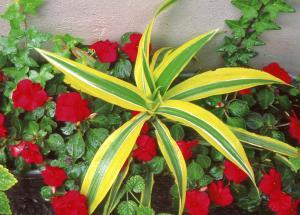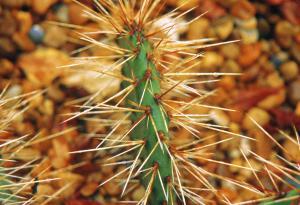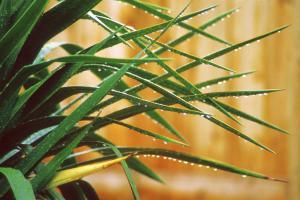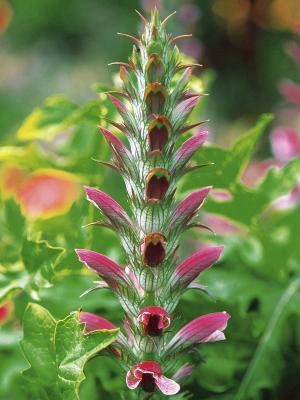By Theresa Forte
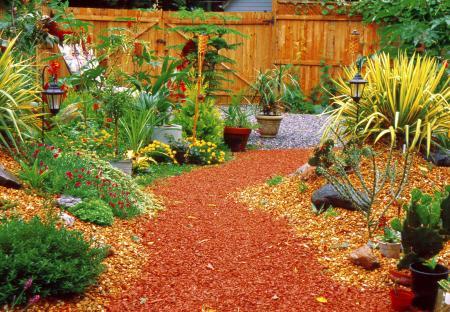 | |
| A brilliant recreation of a Mediterranean garden combines urns, terra cotta pots and vines spilling onto a gravel pathway. |
Once home, we longingly remember the glorious beaches and golden sunshine. As well, the plants and gardens native to these resorts reside in our memories. Palm and banana trees, lush foliage and explosions of colour epitomize the exotic garden. Such a garden encourages feelings of relaxation, pleasure and peace. Tropical garden accents enhance the summer outdoor dining experience. It is little wonder a garden with a tropical flavour is becoming popular among Canadian homeowners. While the notion of visiting an exotic garden may appeal to many gardeners, the effort required to over-winter tropical plants from their own garden is more than most are willing (or able) to commit themselves to. With a little research, this type of garden can be designed using hardy plants that echo the style of their tropical counterparts.
Before starting such a garden, examine the elements that define an exotic garden. Envision an enclosed Persian garden with a serene reflecting pool. Lush, green foliage predominates, the sound of gently moving water echoes in the space. The effect is cool, refreshing and utterly relaxing.
Next, consider a Mediterranean courtyard where statuary, urns and artifacts are featured in sheltered spaces where vines spill over ancient, textured walls. Containers and beds overflow with exuberant, lush foliage. Brilliant floral accents include hot shades of red, orange and golden yellow. In these gardens, leaf texture, shape and form are of utmost importance. The garden and pathways are mulched with pea gravel, while terra-cotta tiles cover the terrace floor.
|
To recreate a tropical garden in our Canadian climate, look for hardy plants with a tropical style. Choose plants with drama and architectural interest. Include variegated foliage, large, glossy leaves, exotic looking ferns, bold ornamental grasses and hardy bamboos. Using hardy look-alikes will eliminate the chore of storing less hardy plants indoors over the winter. If you can't resist the temptation to include true exotics in your garden, take heart. Temperate zones often experience hot, humid summers, with plenty of sunshine. Thunderstorms follow steamy August afternoons. These sultry weather conditions actually encourage the growth of tropical and sub-tropical plants that can evolve into impressive specimens by late summer. The beauty of such a garden is particularly evident in late August and early fall, when many a temperate garden may suffer the effects of heat exhaustion, while its tropical counterpart is flourishing. The Niagara peninsula is affectionately known as the Banana Belt among locals, but sub-tropical bananas are not what we really have in mind. I recently visited a young, tropical-style garden in Niagara Falls, Ont., at the home of Clint Wood, proprietor of Oasis Niagara Gardening, where bananas and palms seem to defy our northern climate. Wood's personal vision of a tropical urban garden included five distinct gardens connected by chipped gravel pathways. The garden included a variety of hardy sub-tropical plants (hardy to zone 5 or 6), such as Yucca brevifolia, banana (Musa basjoo) and palms; exotic ornamental grasses; a desert bed planted with hardy cacti; a raised alpine bed; a section for ferns and another for unusual conifers. A young bamboo grove in the front garden created a screen around the veranda. Wood believes a tropical garden should include at least 50 per cent evergreen materials to maintain interest over several seasons. Along the back of his newly renovated home, stood a charming sunroom with generous windows and soft yellow walls. Wood noted that with our long winters, all Canadians should have a sunroom. It is hard to dispute this recommendation as we sat in the sunroom overlooking his tropical garden on a wet, dreary fall morning. Enclosed with wooden fencing, the garden's raised beds were covered in a decorative mulch of golden pea gravel. This garden was a study of form and texture, coloured in a palette of rich greens, yellows and shades of gold that seemed to radiate warmth on this otherwise bleak morning. Wood recommended Hot Plants for Cool Climates by Susan A. Roth and Dennis Schraderand, The Exotic Garden by Richard R. Iversen, and the internet as excellent references for tropical-style gardening in temperate zones. Roth and Schraderand's book includes an appendix that categorizes both tropical and tropical-looking plants according to their characteristics and applications. Tropical plants include those with fragrant flowers, vines, architectural forms and plants for mixed containers. Most valuable are lists of cold-hardy tropical-looking trees, palms, shrubs, perennials, ferns, vines, bamboos and ornamental grasses and bulbs. Tropical gardens rely on lush, dramatic foliage to set and maintain the mood. Consider plants with richly coloured leaves in shades of burgundy, bronze, mahogany and near-black to create a sense of depth, luxury and even mystery. Golden hues will warm the design; hardy perennials such as hosta, carex and yucca offer selections in this colour range, many with distinctive variegation or markings to reinforce the tropical feel. Silver or blue foliage plants exude soothing and calming influences and prove invaluable as gentle harmonizers. Dramatic patterned leaves such as those of Canna 'Pink Sunburst' and caladiums can create strong focal points. Most important in this type of garden is a spirit of adventure, enlivened through the imaginative use of bold containers, statuary and water features. Plants with distinctive architectural forms and hardy constitutions, such palms, bananas, evergreen ferns, yucca and ornamental grasses, will reinforce the tropical mood, without demanding too much attention.
Hardy perennials with lush foliage:
Hardy perennials with exotic flowers:
Cold hardy ornamental grasses and bamboos: Theresa M. Forte is a garden consultant, columnist and photographer based in Niagara Falls, Ontario. Images courtesy Theresa M. Forte |
